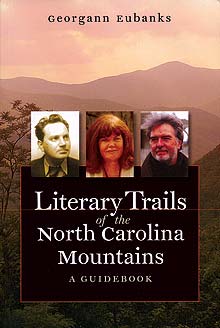Literary Trails of the North Carolina Mountains: A Guidebook (University of North Carolina Press, 2007) by Georgann Eubanks is a revelation. In turns historic tome, travel guide, Southern-heritage volume and trivia collection, the book is exactly the sort of thing that’s so obvious it’s a wonder no one wrote it sooner, and such an ambitious undertaking it’s remarkable the book was ever completed.
But, clocking in at just over 400 information-dense pages, Literary Trails is as complete as any book attempting to catalog a continually evolving culture could hope to be.

The book is organized into tours rather than chapters, each representing a day’s wanderings through a couple of towns with plenty of time allotted for numerous landmarks. Some stops are specifically literary, such as poet Carl Sandburg’s farm, and Lake Eden, the former site of Black Mountain College. Other sites evoke creative inspiration (the hike favored by writer Horace Kephart and his photographer friend George Masa; Texana, the African-American settlement mentioned in Peter Jenkin’s A Walk Across America) or clue the traveler in to mountain culture (a produce stand in Marshall).
Each tour begins with a list of writers associated with that particular area, followed by notes on each stop that incorporate not only current and historical information, but excerpts from books and poems. Little-known facts are in abundance: The Cold Mountain driving tour includes an eight-mile bicycle loop at Sunburst Campground, named for the logging camp used at the start of Champion Paper and described in Donald Davis’s 1994 novel, Thirteen Miles from Suncrest.
Despite a wealth of material culled from regional writers, Eubanks isn’t shy about adding her own poetic kernels. “Soon the daylight will be dimmed by so many overhanging trees and by the sheer rise and drop on either side of the road,” she relates of the Cold Mountain area. And of another route, she writes, “Like the Cherohala Skyway, [‘Tail of the Dragon’] is wildly popular with motorcyclists and drivers of small sports cars who seem to enjoy pushing their luck on relentless curves.”
Readers from Asheville and the surrounding area likely will gravitate to Literary Trail‘s first 10 tours, covering the area from Black Mountain to Dillsboro and Hot Springs to Hendersonville. It can’t be helped—we live here so we’re compelled, like gossip hounds, to read every word about our own stomping grounds. But with Eubanks’ thorough treatment, even those well-trod paths turn up a few surprises. Tour 8, the Weaverville to north Asheville trek, begins with a list of area writers. Contemporary authors Richard Chess, Tommy Hays and Valerie Leff are listed along with notable Asheville names like O. Henry and Thomas Wolfe, F. Scott Fitzgerald buddy Tony Buttitta and singer Nina Simone.
A faded image of teenage Wilma Dykeman posing with Wolfe at a cabin in Oteen is included in the book’s admirable collection of photos. Prime Buncombe County tidbits reveal that Weaverville’s Bess Tilson Sprinkle Memorial Library houses volumes on local history, and north Asheville’s Log Cabin Motor Court was used in the filming of 1950s movie Thunder Road.
The book is rife with factoids. For example, Sylva is the home of young-adult literature writer Sue Ellen Bridgers, who has worked on films with her son Sean, whose acting credits include Nell, Sweet Home Alabama and Deadwood. Also, Highlands poet Jonathan Williams (Tour 3) was born in Asheville the same year that Wolfe’s Look Homeward Angel was published, and he later attended Black Mountain College (Tour 1). And Highlands-born actress Collin Wilcox appeared in—among other films—Journey of August King, which was based on the book by Asheville-born author John Ehle).
Literary Trails also offers plenty of utilitarian travel tips. Maps are clear and plentiful, but more important are the copious asides. Note that wild-strawberry-picking opportunities are few and far between, but springtime visitors to Robbinsville can check out the state’s premier ramp festival.
Overall, Literary Trails is an impressive read both for locals and Western North Carolina’s ex-pat population, but any literary buff is sure to enjoy the detailed text, well-chosen excerpts, countless film references, excellent historic and contemporary photo collection and well-organized tour routes. Best of all, however, is Eubanks’ well-proven point that WNC’s literary heritage is a rich work in progress.
who: Georgann Eubanks
what: Reads and discusses Literary Trails of the North Carolina Mountains
where: Malaprop’s
when: Saturday, Feb. 2. 7 p.m. (Free. www.malaprops.com or 254-6734)



Can I get you to look at and consider mentioning The Madison County Independent Literary Journal?
http://estuarypublications.com/MCILJ.html
Take a look, think about it, thanks.
r. mansfield
estuarypublications.com
Thanks for mentioning the online journal for Madison County writers, but we got only one response, so well,as they say, that’s the end of that dream. But, thank you. Henry Edward Fool’s new book, When I Was a Low-Life will be available August 5.
r. mansfield
estuarypublications.com